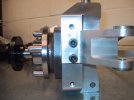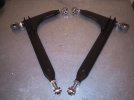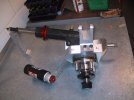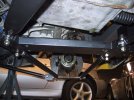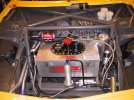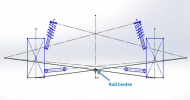To follow up on Ulix's question, I have always been lead to believe that for the rear of the X, the control arm should be basically flat (parallel) to the ground. In this case, the inboard pickup point on the control arm lines up with the ball join on the rear upright. I always then made the front just a hair higher than the rear.
This was kind of the "this seems to be fast" setup which we all shared back in the day in the Pacific Northwest between Mike Mittlestead and the gang.

Again, though, this setup was mostly for very light street duty and mostly autocross action.
From a previous post:
"That said and given there are absolute geometric limitations to the suspension parts in the exxe, it makes sense to limit the suspension travel to keep the suspension part curves reasonable. This is partly due to the need for camber control and control of how much the dynamic roll center is allowed to move around. This translates to what is perceived as high spring rates, but they are not that high once cornering roll angles are considered, the spring rates are simply a product of the cornering loads involved and what is needed to keep the suspension curves reasonable.
~Typically, the LeMons chassis which is stock begins with setting the ride height with the front lower control arm about level with the road level.~
Once this is set up, put the chassis on the corner weight set up, level the rest of the chassis and get the weight per corner reasonable and cross weights near 50%. This means same tire pressures all around with typical driver weight in chassis. Beginning static camber about 3 degrees negative rear, 2 degrees negative front. The steering links have been modified to allow bump steer adjustment which should be done once the static ride height is set. Rubber bushings have been replaced with alloy steel, fiber reinforced teflon liner spherical bearings made by Spec-Line (aerospace supplier) Spherical bearings should be staked at the outside of the bearing to pre-load the bearing and lesser quality spherical bearings will not last. If crappy spherical bearing or rod ends are used, they make chassis set up awful as they will not hold a setting and be repeatable. Dampers must have the ability to control the spring rates involved. Memory notes 550lb/in front and 425lb/in rear (?) no stability bars on a 1,700 pound car. Loaded roll angles are about 2 ish degrees. Chassis easily produces 1G on track with DOT 180 tires. Rear spring/damper rates were tweaked a few times to deal with corner exit wheel spin, there is enough torque from that rotary to make this a very real problem."
There are low cost threaded collar kits known as "LeMons lowering specials" found on eBay for not a lot of $. When these first appeared en-mass on LeMons cars, the Lemons folks went looking to discover they were very much low-$.. They work ok, sort of ok. What is often not appreciated, traction...
xwebforums.com
What works good on the track centric car might not work at all on a car driven on public roads. It all comes down to trade-offs and a long list of other factors.
Corning on the bump stops is more common than realized. Given there has been so much discussion about the Miata (NA/NB) suspension, that suspension has been designed to corner on its bump stops as a ride corning roll trade off. Cornering on bump stops allows a lower/softer spring rates and damper ratios that deliver a ride the majority of Miata owners/drivers will accept. To limit body roll in the corners, the Miata suspension limits body roll by using the bump stops as a means to effectively increase spring rates while allowing softer/lower rate springs to be used for straight line ride quality. Don't think the Miata is the only car to do this, cornering on bump stops has been done on open wheel real race cars by shaping the bump stops on Koni race dampers.. It works and can be very effective if properly done.
It is much about goals and needs and trade offs.
Two of the most interesting suspension developments with exception to the Citroen DS/ID Hydropneumatic system would be:
~Aero via reducing the air pressure or create a vacuum under the car body effectively and greatly increasing the down force generated on the car body which can Greatly increase the grip from tires..
~Lotus active suspension.. which effectively controls suspension geometry as needed for road, cornering loading and more..
All of which brings up the question and topic of how much the motoring public values suspension/chassis excellence. IMO, majority of motorist and enthusiast to some degree do not have a good idea or broad experience with truly excellent chassis/suspension motor vehicles as many lack the driving skills and broad exposure to a wide variety of suspension/chassis motor cars.. What is easiest to judge, easy to access and very salable is straight line acceleration and the numeric value of "Horse Power"... Assessment and judgement of chassis/suspension performance is a LOT more difficult and not easy in many ways. Yet wonky suspension/chassis behavior can promote and habituate bad driving/motoring habits that are difficult to un-learn.
~This is one of the many reasons why the exxe remains an under appreciated gem by most motoring folks and motoring media.
There is another factors not mentioned yet in this discussion, location of weight CG. If the weight CG is put at the driver's lower back, it greatly aids in the ability of the driver to access and "feel" how the car is behaving. This is due to the lower back being the human balance point for standing and more. If the weight CG is placed there (as in the exxe) the car can become an extension of the driver in many ways. Cars that are not designed this way tend to disconnect the driver from the feel of the car based on the driver's lower back. Example would be the Miata NA/NB, it has a weight CG at the steering wheel, appealing for some, not workable for others..
Bernice

